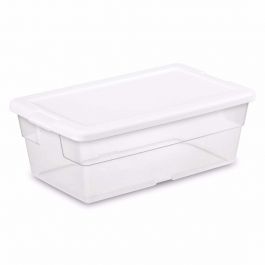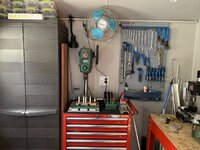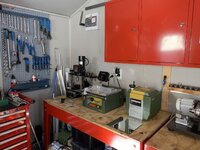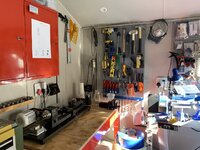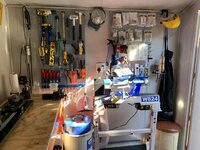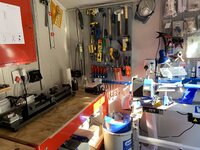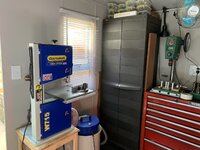JonathanF1968
Member
I'm interested in seeing what your ingenious methods are for storing and organizing tools, and also, fasteners, finishes, lumber, etc. Basically, I want to see the clever details of your shop, and also, hear your ideas about general philosophy of these matters, such as what goes on a pegboard, what goes on a cart, what goes on a shelf, what goes in a drawer, etc., and why.
Photos would be greatly appreciated.
Most of my chisels are half buried in a heap of sawdust on my workbench. This is to say, my preference is that really good ideas be suggested here, rather than "Well, this is how I do it...." if the way that you do it is just awful!
I will share one thing I'm doing now that's helping me, which is that I'm using a label maker to indicate what is in a series of plastic bins (from dishwasher detergent pellets). So, I've got one marked "Hole Saws," one marked "Jointer" (all the bits and bobs from a little jointer that I took apart and will put back together someday maybe), one for "Angle Grinder Discs," and so on, and they are neatly aligned on a shelf. (Some are in close proximity to things they support, while others are independent.) The label maker makes it tidy and clear.
And recently, I built a big shelf on wheels, on which I store all my hand-held power tools. (I expect to move it once a year to access something behind it.) It's nice that they all have a home, rather than being scattered around my house, barn, kids' rooms, etc. And it makes it harder to forget what I have (and also a reminder that I need to stop rescuing cheap broken drills from the dump.)
Here's a question. Say you find a screw on the ground. It is in perfect condition. Where does it go? Trace its journey, for me, from being in chaos to being in a perfectly ordered system.
Me, I have an embarrassing number of buckets/jars/etc. with miscellaneous doodads in it, and that screw will currently have a one way ticket into just another area of chaos. Not only that, but I have quite a few similar stashes from my grandfather's shop. His junk collections are more interesting than mine. Mostly cigar boxes, where he might have a playing card, a corroded penny, a random part from a sewing machine (he was an upholsterer), a human tooth, a box of staples, and a few screws of different sizes. And often, a very worn, very poor quality pocket knife. (I have a lot of his terrible pocket knives.) But I digress. The point is, I need some systems, or I'm going to be on one of those TV shows, soon, where someone stages an intervention.
Photos would be greatly appreciated.
Most of my chisels are half buried in a heap of sawdust on my workbench. This is to say, my preference is that really good ideas be suggested here, rather than "Well, this is how I do it...." if the way that you do it is just awful!
I will share one thing I'm doing now that's helping me, which is that I'm using a label maker to indicate what is in a series of plastic bins (from dishwasher detergent pellets). So, I've got one marked "Hole Saws," one marked "Jointer" (all the bits and bobs from a little jointer that I took apart and will put back together someday maybe), one for "Angle Grinder Discs," and so on, and they are neatly aligned on a shelf. (Some are in close proximity to things they support, while others are independent.) The label maker makes it tidy and clear.
And recently, I built a big shelf on wheels, on which I store all my hand-held power tools. (I expect to move it once a year to access something behind it.) It's nice that they all have a home, rather than being scattered around my house, barn, kids' rooms, etc. And it makes it harder to forget what I have (and also a reminder that I need to stop rescuing cheap broken drills from the dump.)
Here's a question. Say you find a screw on the ground. It is in perfect condition. Where does it go? Trace its journey, for me, from being in chaos to being in a perfectly ordered system.
Me, I have an embarrassing number of buckets/jars/etc. with miscellaneous doodads in it, and that screw will currently have a one way ticket into just another area of chaos. Not only that, but I have quite a few similar stashes from my grandfather's shop. His junk collections are more interesting than mine. Mostly cigar boxes, where he might have a playing card, a corroded penny, a random part from a sewing machine (he was an upholsterer), a human tooth, a box of staples, and a few screws of different sizes. And often, a very worn, very poor quality pocket knife. (I have a lot of his terrible pocket knives.) But I digress. The point is, I need some systems, or I'm going to be on one of those TV shows, soon, where someone stages an intervention.

